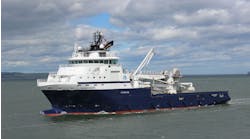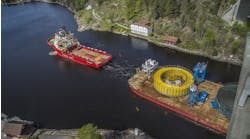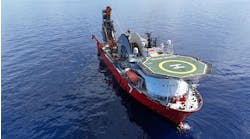Eldon Ball - Houston
The deepwater oil and gas sector will spend $162 billion over the period 2009 to 2013, 36% more than the amount spent in the preceding five-year period, according to a forecast by energy analysts Douglas-Westwood.
The bulk of deepwater developments are being led by major oil companies and well-placed NOCs that Douglas-Westwood believes will not be hit by the economic downturn and turmoil in the debt markets to the same extent as smaller players.
However, some impact on the sector may be felt through those deepwater operators that rely on external project finance. The result is that some delays to projects are inevitable until the financial markets settle.
That’s the conclusion of this month’s special report authored bySteve Robertson and Thom Payne of Douglas Westwood Ltd.
Overall, they say, the deepwater sector is forecast to continue its growth trend from 2010 onwards, reaching an annual total of over $35 billion by 2013. Between 2009 and 2013, expenditure in the deepwater sector is projected to expand at a compound annual growth rate (CAGR) of 3.6%.
See their full report beginning onpage 32.
Subsea separation, boosting, compression meeting challenges for the future
Subsea separation, boosting, and compression by equipment on the seabed currently form the future, especially for deep and ultra deepwater, and for frontier areas with little infrastructure or local demand.
In this series of three separate articles,Gene Kliewer, Technology Editor, Subsea & Seismic, presents a status report on three separate, practical applications of leading-edge subsea technology – subsea separation, boosting, and compression. Each article draws from technical presentations made at the Deep Offshore Technology International Conference in Perth, Western Australia, and on a related Offshore webcast. (The webcast is available online at www.offshore-mag.com.)
His series begins onpage 88.
As a further reference see theWorldwide Survey of Subsea Processing: Separation, Compression, and Pumping Systems poster published in the March 2009 with an overview introduction and available online at www.offshore-mag.com/resourcecenter/os_poster_series.cfm" target="_new">http://www.offshore-mag.com/resourcecenter/os_poster_series.cfm.
Innovative DWC technology raises production, cuts cost
New bit technology that makes it possible to drill with casing provides a significant advance for reducing time and costs when new wells must be drilled and there are no more slots on the seafloor template.
A project off the coast of Congo in West Africa used this technique to good results when the operator wanted to drill another well to explore another structure of the reservoir to raise production but had no available slots.
AsJohn Waggoner, Technology Editor, Drilling & Production, reports in a special Bit Technology section this month, the project’s platform had a template with eight slots, all of which had directional wells drilled though a 30-in. conductor casing. To secure an extra slot, the operator decided to set a 30-in. diverter with a 2° angle diverter on the seabed, to allow drilling a new hole with a 26-in. roller cone bit. Then, 20-in. casing would be run and cemented through the diverter.
The problem was re-entering the 26-in. hole with the 20-in. casing due to the sag of the drilling assembly at the exit of the diverter. The solution was drilling with casing. This involved designing a special 24-in. casing drilling bit to be run through the diverter on a 20-in. casing string. This solution made it possible to secure the extra slot and get out of the trajectory of the existing well, saving time and money.
See his full report onpage 70.
To respond to articles in Offshore, or to offer articles for publication, contact the editor by email ([email protected]).


